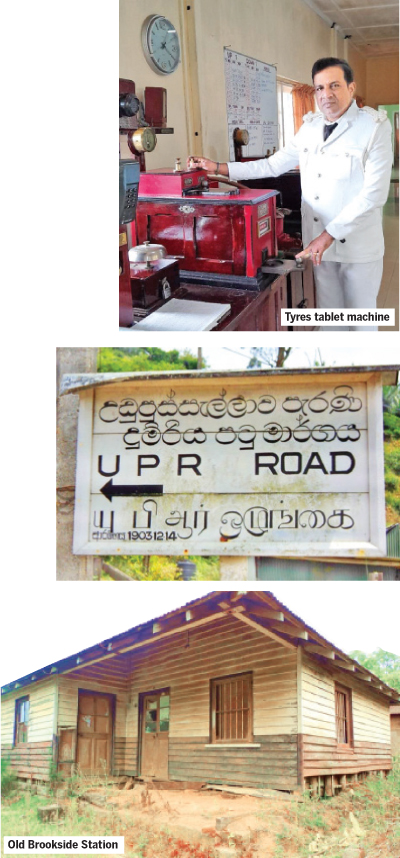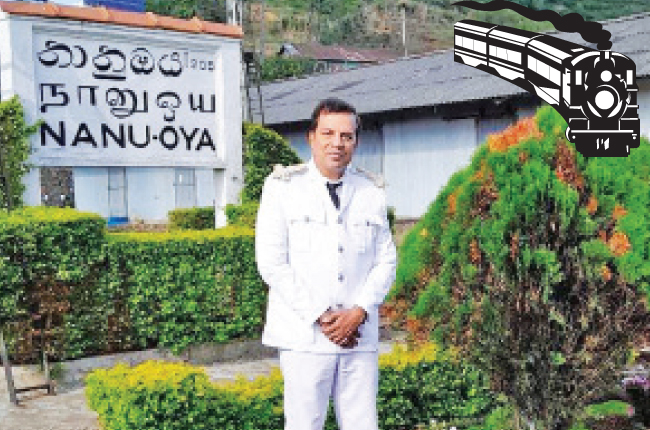The golden era of the Ceylon railway is considered to be from 1858 to 1927. The history of our railways is deeply connected to the vintage tea industry. Tea was first grown commercially in Ceylon by a Scotsman named James Taylor, on a coffee estate called Loolecondera (Kandy) in 1867. Taylor was encouraged by the dynamic Dr.Thwaites, Director of the Royal Botanical Garden at Peradeniya. He planted 20 acres of tea grown from seed imported from India. In response to requests to open up plantations, the government sold virgin crown land around Kandapola to pioneer planters in the 1870s.
 The narrow gauge railways were used in three sections of Ceylon where sharp curves were available due to the geography of the region. Originally these types of railways were used way back in 1906 connecting broad gauge from Nanu Oya to Ragala via Nuwara Eliya, popularly known as Uda Pussellawa Railway (UPR). The Nuwara Eliya Railway line from Nanu Oya to Ragala was constructed in three-and-a-half years starting from November 1900 with the distance covering 19 miles. At Nanu Oya, the tea chests were transferred to the main broad gauge line, and sent for delivery to the Colombo goods wagons. After the auction, the tea chests went by steamship to England and Australia.
The narrow gauge railways were used in three sections of Ceylon where sharp curves were available due to the geography of the region. Originally these types of railways were used way back in 1906 connecting broad gauge from Nanu Oya to Ragala via Nuwara Eliya, popularly known as Uda Pussellawa Railway (UPR). The Nuwara Eliya Railway line from Nanu Oya to Ragala was constructed in three-and-a-half years starting from November 1900 with the distance covering 19 miles. At Nanu Oya, the tea chests were transferred to the main broad gauge line, and sent for delivery to the Colombo goods wagons. After the auction, the tea chests went by steamship to England and Australia.
Darjeeling model
CGR prudently introduced the narrow gauge line of 2’6” in high altitude areas, which is in the model of ‘Darjeeling line’ which was paved in the Himalayan Ranges in India. This 83 km. long section connecting Darjeeling with the railhead at Siliguri is of great importance and has been bestowed World Heritage Site status. The railway line from Siliguri to the beautiful hill section of Darjeeling is considered an engineering feat and passes through very picturesque country.There are 13 stations including New Jalpaiguri and Darjeeling with an average inter distance of 6 to 7 km. The Ghum station is the second highest railway station in the world to be reached by steam locomotive. Considering the above Himalayan Darjeeling concept, the Ceylon Government Railway (CGR) decided to start the Kelani Valley Line (KV line) from Colombo to Opanayake in the Ratnapura District, which is a narrow gauge line, established in 1902.
Planter’s choice
 Due to the introduction of railway in 1885 by CGR, Uda Pussellawa Planters Association requested the narrow gauge line from Nanu Oya to Nuwara Eliya, which is 12.4 miles from the British governor Sir West Ridgeway, who was on a trip to Nuwara Eliya on 25 April 1895. The Governor proposed to Colonial Secretary Noel Walker about the above request from Uda Pussellawa Planters Association many times and the Colonial Secretary had rejected the request considering that the line is not economically viable.
Due to the introduction of railway in 1885 by CGR, Uda Pussellawa Planters Association requested the narrow gauge line from Nanu Oya to Nuwara Eliya, which is 12.4 miles from the British governor Sir West Ridgeway, who was on a trip to Nuwara Eliya on 25 April 1895. The Governor proposed to Colonial Secretary Noel Walker about the above request from Uda Pussellawa Planters Association many times and the Colonial Secretary had rejected the request considering that the line is not economically viable.
The closest station to Nuwara Eliya on the existing heavy gauge railway line (Main Line) was Nanu Oya railway station. But Governor West Ridgeway was determined to continue the concept since he can transport and export the produce at Nuwara Eliya, Kandapola, Ragala and Mathurata areas which supplied the finest tea specialties in Sri Lanka. The Nuwara Eliya Assistant Government Agent C.M. Lashinton proposed another narrow gauge line from Talawakelle to Diyagama which was not activated.
On 14 December 1903, the Governor completed 12 miles of the railway line as the first stage up to Nuwara Eliya. It was opened by Sir Henry Blake. Due to this the Colonial Secretary agreed to allocate funds for the project. Subsequently, the line was extended to Kandapola and Ragala on 1 July 1904 for cargo transportation. The cost of construction was about £5,500 per mile. After testing with cargo for a few months, CGR started operations for passengers on 25 July 1905. The total cost of this entire railway network amounted to approximately Rs. 1.6 million, and the project comprised of three phases.
The line was constructed in 2 feet 6 inch gauge. The total length from Nanu Oya to Ragala was 31 km (19 miles), and five main railway stations were built on the line: Blackpool, Nuwara Eliya, Kandapola, Brookside and Ragala. The abandoned Brookside station was used later as a wine store. The abandoned Ragala Station was used as a bus stop by the villagers. The highest elevation on the line was at Kandapola railway station. Its elevation was 1,925 m above sea level. Three smaller stations named Pedro, Summer Hill, and Portwood were also constructed between the main stations of Nuwara Eliya and Kandapola; the purpose of these minor stations was to transport tea throughout the region.
CGR started this project with four engines prepared by a British company called the Sharp Stewart Company. The Sharp Stewart & Company was a steam locomotive manufacturer, initially located in Manchester, England. The company was formed in 1843. In 1862, the company began making larger engines, first some 4-6-0 saddle tank engines for the Great Indian Peninsula Railway. A 4-6-0 steam locomotive, under the Whyte notation for the classification of steam locomotives by wheel arrangement, has four leading wheels on two axles in a leading bogie and six powered and coupled driving wheels on three axles with the absence of trailing wheels.
The company made an engine named as Engine Model as UPR Class L1 with a speed of 12 miles per hour. The famous CGR class H1 steam engine has also performed on this line for a few years. The CGR Class H1 was a 2-4-0+0-4-2T steam locomotive of the Garratt type built by Beyer, Peacock & Company, England for the Ceylon Government Railway (CGR), now Sri Lanka Railways. Only one locomotive of this type was built, and its CGR plate number was 293. Class H1 293 was the famous Baby Garratt locomotive which was one of a kind.
The CGR class H1 was a steam locomotive of the Garratt type built by Beyer, Peacock and Company for the Uda Pussellawa Railway (UPR). Garratt locomotives were articulated steam locomotives which were more powerful than other conventional steam engines.
This steam locomotive entered service with CGR in 1931. The locomotive was used for working passenger and freight services in Udupussallawa railway. This locomotive met with a serious accident near Nuwara Eliya when it was hauling a freight train at excessive speed in 1941 and was silent for some years. In 1944 this was repaired and this was seen again in service. Even today the narrow gauge track is seen at the Nanu Oya station. The Chief Station Master showed me the Tyres Tablet Machine still in operation.
In 1942, the first stage from Nanu Oya to Nuwara Eliya was removed, and later in 1948 the remaining part up to Ragala was removed. On 2 August 1948 all services were withdrawn and the line was completely removed. This vintage railway line delivered the best Ceylon tea to Colombo decades ago. I spoke to locals and tourists who knew about this bygone era and they agreed that it would be good to restore this track, and create a beautiful train journey to boost tourism for this region.
Dishan Joseph






